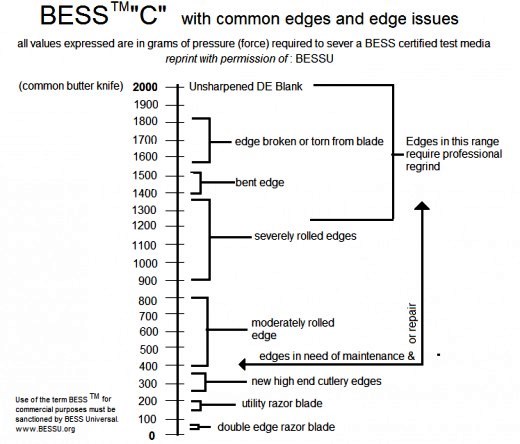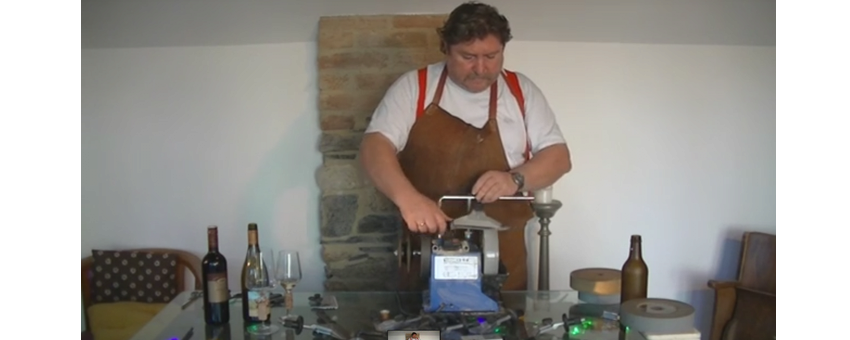BESS - Messsystem Quantifizierbarer Test zur Messerschärfe

Das BESS Messsystem (Brubacher Edge Sharpness Scale) vermittelt über den Druck in Gramm (1 kg = 9,8066 Newton), den es benötigt, einen normierten Testfaden zu durchtrennen um unmittelbare Aussage über die Schärfe einer Klinge bzw. über die Breite der Klingenspitze zu erhalten.
Bei z.B. 100 BESS ist der Radius der Spitze 100 nm (Nanometer, 1/1.000.000 –ein Millionstel Millimeter), d.h. die Klingenbreite beträgt 200 nm oder 0,2 µ (Mikrometer, 1/1000-stel eines Millimeters).
Eine frisch aus dem Wachspapier ausgepackte doppelschneidige Rasierklinge hat z.B. 50 BESS, sehr gut schneidende Küchenmesser rangieren zwischen 100 und 400 BESS. Über 500 BESS sollten die Klingen abgezogen werden, über 1000 BESS benötigen die Klingen einen professionellen Nachschliff.
 .
.
BESS TM (Brubacher Edge Sharpness Scale) is a means of quantifying the sharpness of any edge designed for cutting. BESS is truly universal in that users of the BESS don't have to own special instrumentation in order to derive benefit from the scale. They don't have to understand or have had experience with sharpening edges either because the BESS is based on the sharpness of a common double edge razor blade. Just as you know that 0C or 32F is cold you know that a double edge razor blade is sharp and BESS relates all sharpness levels to those of a DE razor blade. When BESS quantifies a sharpness level it means that the sharpness level has been equated to a number. For BESS that means a scale of 0 - 2000 with "0" being the sharpest level and "2000" the dullest. This scale number range was not just picked out of "thin air". Each number in BESS relates directly to an amount of pressure, expressed in grams, required to sever a test media. The pressure measurement expressed by any BESS certified instrument then directly links to the BESS without further interpolation. An instrument output of "345" is a BESS score of 345 as well.
The BESS is now in two parts; the "BESS "A"" and BESS "C". Whether the "A" or "C" scales are used is dependent on the type and style of instrumentation utilized. Instruments that include a 50 gram piston weight will use the A scale and those that do not will use the C scale. "A" and "C" scales are easily converted between by either adding or subtracting 50 grams from the measurement result.
BESS is administered by BESSU (BESS Universal) a not for profit organization www.bessu.org.


